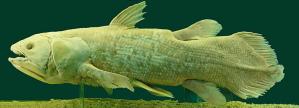The fossil record provides many examples of living organisms that have remained stable in their form and structure over many millions of years--sometimes over hundreds of millions of years.Explore Evolution, p. 25
Summary of problems with claim: This is not evidence against evolution.
Full discussion: Explore Evolution brings this up to suggest:
- Something is wrong with the model of evolution if organisms do not change.
- Something may be wrong with the geologic timeline, if organisms show no change over such a long time period.
 Coelacanth: a "living fossil." Image from WikiCommons.
Coelacanth: a "living fossil." Image from WikiCommons. The long-lived, unchanged existence of an organism in the fossil only poses a problem to evolution is one makes the (false) assumption that change occurs at a steady background pace. In fact, a better analogy is Newton's First Law: "Objects at rest stay at rest unless acted upon." If an organism lives in a stable environment and is able to reproduce in sufficient numbers to pass on its genes, then there is no impetus to change.
Other examples of long-lived, relatively unchanged species include sharks, the coelacanth, the oppossum, crocodiles, and the horseshoe crab.
